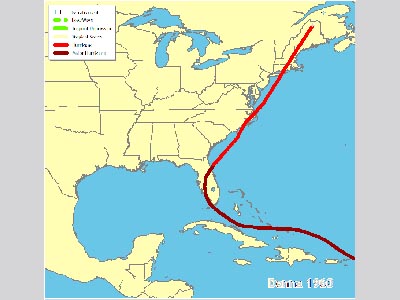Hurricane Donna, a Cape Verde-type hurricane, was the only system to reach major intensity (Category 3 or higher on the Saffir-Simpson Hurricane Wind Scale) during the 1960 hurricane season. It was first detected as a tropical wave off the coast of Africa on August 29, 1960. The system quickly intensified as it moved over the Atlantic, becoming a hurricane on 1 September. It passed over the northern Leeward Islands (U.S./British Virgin Islands, etc.) on 4-5 September as a Category 4 hurricane. On 5 September, still at Category 4 strength, the system passed through the southeastern Bahaman islands and brought 254-381 mm (10-15 in) of rainfall to Puerto Rico where 107 people drowned in the resulting floods. Regaining any intensity it may have lost while crossing the Bahamas, the hurricane reached the Florida Keys by 9 September with sustained winds reaching approximately 222 km/h (138 mph) and gusts up to at least 286.5 km/h (178 mph) (near the storm’s center). As a ridge of high pressure in the north began to decay around 10 September and the Westerlies began to increase, Donna recurved and crossed the Florida Peninsula on 11 September. Despite its path over land, the storm remained intense and reorganized when it moved back into the Atlantic. Donna struck eastern North Carolina (and parts of South Carolina) as a Category 3 storm on 11 September. Upon reaching the ocean a third time, Hurricane Donna accelerated, crossing Long Island and then the New England region on 12 and 13 September (as a Category 3 system in Long Island, Category 1 or 2 everywhere else).
Hurricane Donna caused a storm surge of up to 4 m (13 ft) in the Florida Keys, 3.4 m (11 ft) along the SW coast of Florida, 1.8–2.4 m (4-8 ft) in North Carolina, and a 1.5-3 m (5-10 ft) surge along the New England coast. Florida also received 152.4- 304.8 mm (6-12 in) of heavy rainfall (all other locations received 101.6- 203.2 mm [4-8 in]). The storm surges and hurricane force winds led to $6.6 billion (2009 USD) of overall damage. Due to these devastating impacts, “Donna” was retired from the list used by the National Hurricane Center to name storms, replaced by “Dora” in 1964. Fast Facts:
Sources: Dunn, Gordon E. 1961. The Hurricane Season of 1960. Monthly Weather Review. Pp 99-108. NOAA Hurricane Preparedness site (Hurricane History): http://www.nhc.noaa.gov/HAW2/english/history.shtml#donna Wikipedia: Hurricane Donna http://en.wikipedia.org/wiki/Hurricane_Donna |


